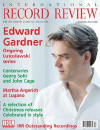Texte paru dans: / Appeared in:
*

International Record Review - (12/2012)
Pour
s'abonner / Subscription information
Ramée
RAM1204
4250128511056 (IDV30)
Consultez toutes les évaluations recensées pour ce cd
~~~~ Reach all the evaluations located for this CD
"This is a wholly delightful production, which I will certainly continue taking down from my shelves long after this review is published".
Over the years, I have reviewed my fair share of English music for viol consort from the sixteenth and seventeenth centuries. I have usually paid tribute to the intellectual strength and compositional ingenuity of this very English tradition. However, it occurred to me recently that whenever a review is completed, I have put the disc into the appropriate section of my CD library, where it has remained undisturbed ever since. I would not go as far as a friend who, having recently sat through a concert of them, described such works as ‘musical wallpaper’; but it seems I respect them more than I actually enjoy them - at least when heard in large slabs as they are usually presented on disc. This delightful disc from the ensemble Musicke & Mirth shows there actually was a very different and, to me, more engaging repertory for viols in seventeenth-century England. After all ‘mirth’ is not a quality one would usually associate with viol consorts; but it seems English viol players were not always teaming up with four or five colleagues to perform earnest ‘In nomines’ and the like.
Following the language of the composer Christopher Simpson, who was one of its major exponents, Musicke & Mirth calls this alternative repertory ‘division musick’. The improvised playing of divisions or ornamented variations on an original or pre-existing melody or ground was a staple of virtuosi on all instruments in this period. This recording explores the rich tradition of fully composed divisions, focusing on those for two viols and, in many pieces, including a fully developed continuo. In all these respects they are far more ‘Baroque’ in style than viol consorts, which were really a continuation of a Renaissance genre that survived uniquely in England almost until the eighteenth century. Some composers wrote in both the more learned consort style and the flashy and exciting division style. The programme also includes some division music for violin, written in very similar style.
The jaunty echo effects in the opening track, the first movement of a suite by John Jenkins (it is called ‘Ecco Coranto’), sets the mood for what is a delightfully virtuosic and unfailingly engaging programme. Some of the music is witty and playful, such as Solomon Eccles’s A Division on o Ground b Mr. John Eckles (sic); some is comparatively serious, such as Simpson’s Division for two viols No. 5. The closing suite, Jenkins’s Lyra Consort in D minor, is perhaps the music with the greatest depth in the programme; but it also contains some of the flashiest passagework. Finally on the music, is it my imagination or is not the first ‘Coranto’ in Jenkins’s Lyra Consort in D minor at times strangely reminiscent of part of the theme music to the TV series Game of Thrones?
Simpson told his readers that the division viol should be smaller than a consort bass viol and ‘the Sound should be quick and sprightly, like a Violin’. The two gambists of Musicke & Mirth, Jane Achtman and Irene Kiein, certainly match Simpson’s prescription. Their viols are bright and nimble; their playing is agile, witty and really quite violinistic. Conversely, in the pieces in which the guest artist, Amandine Beyer, appears, her Baroque violin actually sounds rather reedy and gamba-like. In some of these, I was momentarily unsure whether I was listening to a violin or a viola da gamba. The other guest performer is Johannes Strobl, who plays organ and virginals with tremendous verve and buoyancy. He contributes considerably to the fun and enjoyment of the disc. As ever with Ramée releases, the booklet notes and recording quality are exemplary and the CD itself is visually most appealing.
This is a wholly delightful production,
which I will certainly continue taking down from my shelves long after this
review is published.
Fermer la fenêtre/Close window
Cliquez l'un ou l'autre
bouton pour découvrir bien d'autres critiques de CD
Click either button for many other reviews


